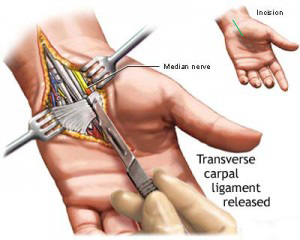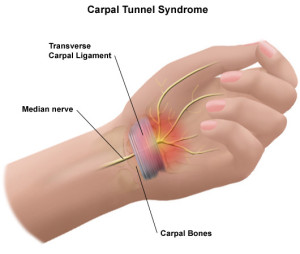The carpal tunnel is a space on the palm side of the wrist and hand which is formed by the small bones of the wrist (carpal bones) and a strong fibrous band (transverse carpal ligament) overspanning them.
Within the carpal tunnel runs the median nerve which is the nerve supply for a number of muscles of the hand/ fingers as well as the feeling (sensation) within the thumb, index and middle finger.
Carpal Tunnel Syndrome occurs if the median nerve is compressed within the carpal tunnel. Typical symptoms are pain, tingling or reduced sensation in the thumb and first two fingers. Pain and discomfort is often worse at night and may get better while elevating or shaking the hand. Sometimes grip weakness and muscle wasting are seen in advanced stages. One or occasionally both hands are effected.
Diagnosis is made based on clinical symptoms and tests (Phalen, Tinel) and objective nerve conduction studies (typically done by a neurologist).
Most effective treatment is surgical by dividing the transverse ligament under local or general anaesthesia (see diagram below).
This procedure is easily done within 15-20min. in a day surgery setting. After the operation the use of that hand is limited for 7-10 days.

